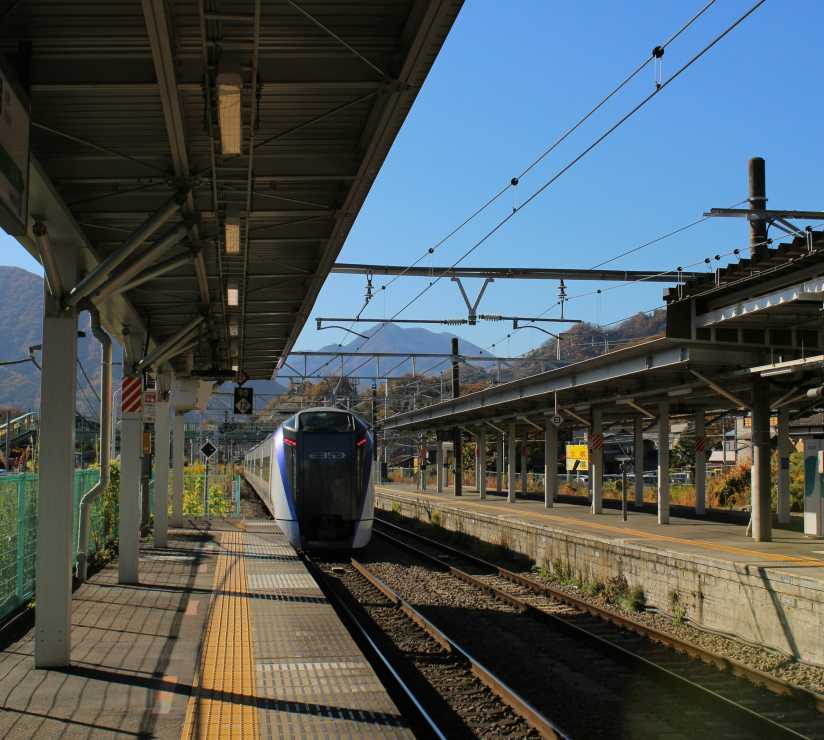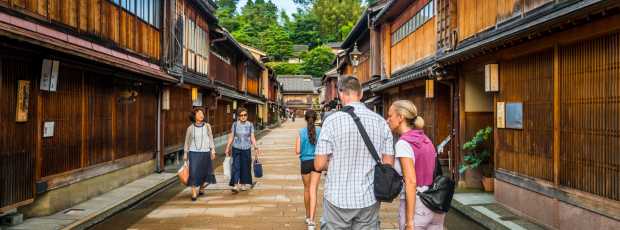Table Of Contents
- Early Morning: Arriving at the Heart
- First Stop: Kiyomizu-dera Temple in the Dawn Light
- Walking Down: Higashiyama's Traditional Streets
- Mid-Morning: Gion District and the Geisha World
- Late Morning Transit: Moving North with Purpose
- Midday Highlight: Kinkaku-ji Golden Pavilion
- Lunch Break: Arashiyama and the Bamboo Forest
- Afternoon Energy: Fushimi Inari's Thousand Gates
- Late Afternoon: Nishiki Market Food Adventure
- Evening Transition: Pontocho Alley's Hidden World
- Night Conclusion: Kyoto Station and Departure Planning
- Essential Logistics for Your Day Trip
- Timing Your Visit: Seasonal Considerations
- What Makes This Itinerary Work
- Beyond the Standard Tourist Path
- Making the Most of Limited Time
The best things to do in a Kyoto day trip always begin before the crowds arrive. I've walked these streets for fifteen years, and just one day in this city can leave you breathless—if you move with purpose. My itinerary isn't about checking boxes—it's about feeling the pulse of Japan's old capital while your feet carry you through centuries of history.
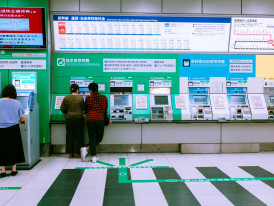
Travelers checking the digital bus schedule boards at Kyoto Station Photo by Christian Chen on Unsplash
Early Morning: Arriving at the Heart
I always tell visitors to take the first train from Tokyo or Osaka. Kyoto Station opens at 6 AM, and by 7:30, you're already moving toward your first temple. The main concourse buzzes with commuters, but you'll want to head straight to the bus terminal on the north side.
The city bus system connects you to just about every shrine and district you'll want to see. A 600-yen day pass, available right at the bus stop, easily pays for itself after two rides. The key to a successful one-day exploration is understanding the rhythm of Kyoto's morning awakening.

Stone steps leading up to Kiyomizu-dera with traditional wooden buildings lining the path Photo by Leopold Maitre on Unsplash
First Stop: Kiyomizu-dera Temple in the Dawn Light
Bus 100 takes you directly to Kiyomizu-dera. The temple opens at 6 AM, and arriving early lets you walk the approach without weaving through shoulder-to-shoulder tourists. The wooden stage juts out over the Higashiyama district and park areas below, like the bow of a ship, offering a sweeping view of Kyoto stretching toward the mountains.
Kiyomizu-dera temple costs 400 yen to enter, but the views are worth every coin. I always spend at least twenty minutes here—not taking photos, just standing still and watching how the city breathes from above. The main hall, rebuilt without a single nail, is a quiet display of the craftsmanship that makes every temple Kyoto offers feel like small miracles.
Looking for a private city experience in Kanazawa?
Explore the city with a local who plans a private day just for you; no groups, no scripts.

Traditional wooden shop fronts with ceramic displays and hanging noren curtains Photo by Winged Jedi on Unsplash
Walking Down: Higashiyama's Traditional Streets
From Kiyomizu-dera, walk down through Sannenzaka and Ninenzaka. These stone-paved streets feel like stepping back two centuries. Small shops sell traditional sweets and tea, but don't stop yet—save your appetite for later. The architecture here shows you what all of Kyoto looked like before concrete and neon.
The walk to Kodai-ji, another beautiful temple Kyoto is famous for, takes fifteen minutes through these winding paths. Kodai-ji, built for the widow of Toyotomi Hideyoshi, offers gardens that change with every season. Even in the short time you have, the zen rock arrangements and perfectly pruned trees remind you why Japan perfected the art of contemplative space.
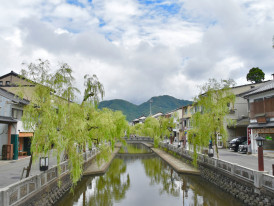
A traditional wooden bridge over Shirakawa canal with weeping willows Photo by Sunao Noguchi on Unsplash
Mid-Morning: Gion District and the Geisha World
From Higashiyama, it's a ten-minute walk to Gion. This Kyoto district still operates as it did centuries ago—ochaya tea houses, traditional restaurants, and the occasional glimpse of one maiko hurrying to her morning lesson. Shirakawa area, north of the main Gion district, offers the most photogenic traditional buildings reflected in the narrow canal.
I recommend walking the side streets rather than just Hanami-koji. Gion Corner might be closed this early, but the residential streets between Shijo and the river show you where real geishas live and work. The mystery isn't manufactured here—it's simply how this world continues to function.
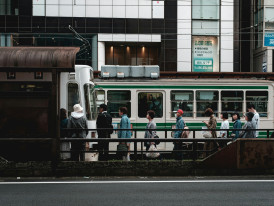
Passengers boarding a bus at a busy Kyoto intersection with traditional and modern buildings visible Photo by Christian Chen on Unsplash
Late Morning Transit: Moving North with Purpose
From Gion, walk to Shijo-Kawaramachi station. The subway gets you to Imadegawa station in twelve minutes, then bus 205 connects you to Kinkaku-ji. This transition from southern temples to northern gardens shows you Kyoto's geographic diversity—each district maintains its own character and history.
The train connections in Kyoto work like clockwork. Unlike Tokyo's overwhelming network, Kyoto's public transport feels manageable. Keep your day pass handy and check the digital displays—buses run every 8-10 minutes on major routes.
What if your day in Kanazawa was planned by someone who knows it — and you?
City Unscripted matches you with a local host who creates a private experience based on your interests, not a set route.
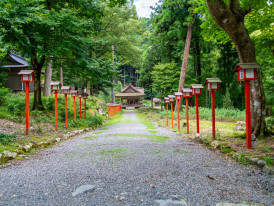
The carefully manicured garden path around Kinkaku-ji with stone lanterns and pine trees Photo by Kazuhiro Yoshimura on Unsplash
Midday Highlight: Kinkaku-ji Golden Pavilion
Kinkaku-ji opens at 8 AM, and by 11 AM, you'll join the steady flow of visitors. The Golden Pavilion isn't just beautiful—it's architectural poetry. The top two floors are covered in genuine gold leaf, and the reflection in the mirror pond doubles the impact.
The temple path is one-way, designed to control the flow of visitors. Don't rush the viewing spots—each angle reveals different details. The garden and park around Kinkaku ji demonstrates classical Japanese landscape design: every stone, tree, and water feature placed with deliberate intention.
From the temple, the walk back to the main road takes ten minutes. This is where efficient planning pays off—you've seen Kyoto's most famous temple without the afternoon crowds that make photography nearly impossible.

A traditional tofu kaiseki restaurant in Arashiyama with tatami seating overlooking a garden Photo by Ying Zhu on Unsplash
Lunch Break: Arashiyama and the Bamboo Forest
Bus 205 to Kyoto Station, then the JR San-in line to Saga-Arashiyama Station. The train ride takes about twenty-five minutes, passing through Kyoto's quieter edges—residential neighborhoods and small temples you'd never spot from the usual tourist routes.
Arashiyama feels like a different world. The bamboo forest glows with natural cathedral light, and the rustle of wind through the stalks replaces the noise of the city. The main path takes about fifteen minutes to walk, but I always stretch it out by wandering the side trails most visitors overlook.
For lunch, find one of the traditional restaurants near Tenryu-ji, a historic temple Kyoto treasure. Tofu kaiseki might sound simple, but in Arashiyama, it's elevated to art. The multi-course meals showcase seasonal ingredients and Buddhist temple cooking techniques. Even a quick version gives you authentic Japanese flavors.

A smaller shrine complex halfway up Mount Inari with city views visible through the trees. Photo by Kouji Tsuru on Unsplash
Afternoon Energy: Fushimi Inari's Thousand Gates
From Arashiyama, take the Keifuku line to Shijo-Omiya, then transfer to Keihan Main Line for Fushimi-Inari station. The journey takes forty minutes, but it's worth every minute of travel time. Fushimi Inari Taisha operates 24 hours, so afternoon arrival works perfectly.
The famous torii gates of Fushimi Inari Taisha begin immediately behind the main shrine buildings. Most people photograph the first hundred gates and leave, but the real experience starts when you climb higher. The full hike to the summit takes two hours, but even thirty minutes up the mountain shows you why this shrine captivates millions.
Fushimi Inari Taisha represents something uniquely Japanese—the intersection of nature worship, business success prayers, and physical endurance. Each torii gate was donated by individuals or companies, creating a tunnel of gratitude that extends up the entire mountainside.
Tip
We match you with the right host, not just any guide.Want to experience the real Kanazawa with someone who lives there?
A fully private experience, planned and led by a local host who tailors the day to you

Customers sampling various pickled vegetables and traditional preserved foods at market stalls Photo by Nuriye Çayhan on pexels
Late Afternoon: Nishiki Market Food Adventure
From Fushimi Inari, the Keihan line takes you directly to Gion-Shijo station. Walk five minutes west to Nishiki Market, Kyoto's 400-year-old food marketplace. This isn't a tourist attraction—it's where locals shop for ingredients and grab quick meals.
The market stretches for five blocks, each stall specializing in specific regional foods. Try konna monja donuts, sample traditional Japanese confectionery, or grab fresh seafood prepared while you wait. The best Kyoto experiences happen when you eat what locals eat.
Don't attempt to see every stall—choose three or four that catch your attention and spend time talking with the vendors. Many speak basic English, and their pride in their craft shows in every recommendation they make.
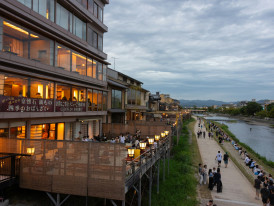
Traditional restaurant balconies overlooking the Kamogawa River with diners enjoying evening meals Photo by Transly Translation Agency on Unsplash
Evening Transition: Pontocho Alley's Hidden World
From Nishiki Market, Pontocho Alley is just a three-minute walk north. Tucked between Kawaramachi and the Kamogawa River, this slim passageway holds some of Kyoto's most atmospheric restaurants and bars. It's so tight that two people can barely pass without brushing shoulders.
In summer, many restaurants extend wooden platforms (kawadoko) over the river. Even in other seasons, the intimate scale and traditional architecture make Pontocho feel like a secret world. This is where Kyoto's nightlife begins, but it operates by different rules than Tokyo's entertainment districts.
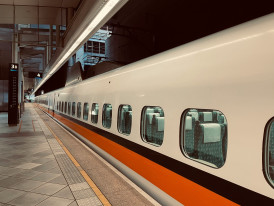
The Shinkansen platform at Kyoto Station with bullet trains preparing for departure to Tokyo Photo by Ting Ting on Unsplash
Night Conclusion: Kyoto Station and Departure Planning
Your one day in Kyoto ends where it began—at Kyoto Station. The evening departure options to Tokyo or Osaka run until 10 PM, giving you flexibility to extend your final meal or temple visit. The station's shops offer last-minute souvenirs, but the real memories are the temple steps you climbed and the flavors you discovered.
Ready to plan your perfect day in Kanazawa?
Start your experience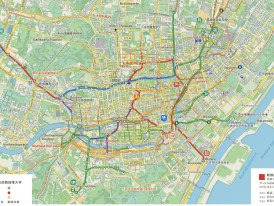
A detailed map of Kyoto showing bus routes connecting major temples and districts
Essential Logistics for Your Day Trip
The success of any day trip depends on smart transportation choices. Keep your day bus pass, download Navitime or Japan Transit Planner for train connections, and remember that most temples charge 300-600 yen entrance fees. Carry cash—many smaller establishments don't accept cards.
Your hotel in Tokyo or Osaka can store large luggage, so travel to Kyoto with just a small day pack. You'll be walking a lot and visiting temples, and everything feels easier when you're packed light. Weather changes quickly in Japan, so pack layers and comfortable walking shoes.
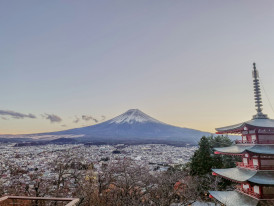
Snow-covered temple roofs in winter with Mount Fuji visible in the distance Photo by Maria Clarissa Badiola on Unsplash
Timing Your Visit: Seasonal Considerations
Spring and fall offer the most dramatic scenery, but also the largest crowds. Summer brings festivals and extended temple hours, while winter provides clearer mountain views and fewer tourists. For things to do in kyoto december, the city takes on a quieter, more contemplative atmosphere.
Each season changes how you experience the city. Cherry blossom season transforms every temple garden, while autumn colors make the mountain hikes around Fushimi Inari spectacular. Plan your clothing and itinerary timing based on seasonal weather patterns.
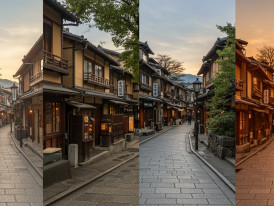
A time-lapse style photo showing the same Kyoto street at different times throughout the day.
What Makes This Itinerary Work
This route flows geographically and logically. You start in eastern Kyoto's temple district, move north through Kyoto to the Golden Pavilion, west to Arashiyama's natural beauty, south to Fushimi Inari's spiritual challenge, then back to central Kyoto for food and nightlife. Each transition builds on the previous experience.
The key is to respect each place's unique character while keeping a steady pace. You can't see everything in one day, but you can feel the essential spirit of Japan's ancient capital. Every temple visit, every meal, every walk through traditional districts adds layers to your understanding.
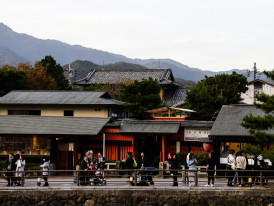
Local residents cycling through a traditional neighborhood with temple roofs visible in the background Photo by Cici Hung on Unsplash
Beyond the Standard Tourist Path
The best experiences happen between the famous sites. The walk from Kiyomizu-dera temple to Gion reveals traditional crafts workshops. The transition from Arashiyama to central Kyoto shows you residential neighborhoods where normal life continues alongside tourism. These connecting moments often become the most memorable parts of your day.
Pay attention to the small details: the way morning light filters through temple eaves, the sound of gravel crunching under your feet on shrine paths, the smell of incense mixed with cedar wood. These sensory memories last longer than any photograph.

A perfectly timed sunset view from Kiyomizu-dera temple overlooking the city of Kyoto Photo by Ricky on Unsplash
Making the Most of Limited Time
One day forces you to prioritize, which often leads to better experiences than week-long stays without focus. You'll see Kyoto's greatest hits while maintaining the energy and attention that extended travel sometimes dulls. The time pressure creates intensity that enhances every temple visit and meal.
Don't try to extend this itinerary by skipping meals or rushing through temples. The rhythm of movement, rest, eating, and contemplation matches how Kyoto itself operates. Honor the pace, and the city will reward your respect with experiences that stay with you long after your train pulls away from the station.
This one day gives you enough of Kyoto to understand why people return again and again. It's not about completion—it's about connection. The temples, food, traditions, and quiet moments between destinations create a foundation for deeper exploration on future visits. But for now, one perfect day in Kyoto provides exactly enough of Japan's cultural heart to satisfy and inspire.
What if your day in Kanazawa was planned by someone who knows it — and you?
City Unscripted matches you with a local host who creates a private experience based on your interests, not a set route.
Want to experience the real Kanazawa with someone who lives there?
A fully private experience, planned and led by a local host who tailors the day to you
